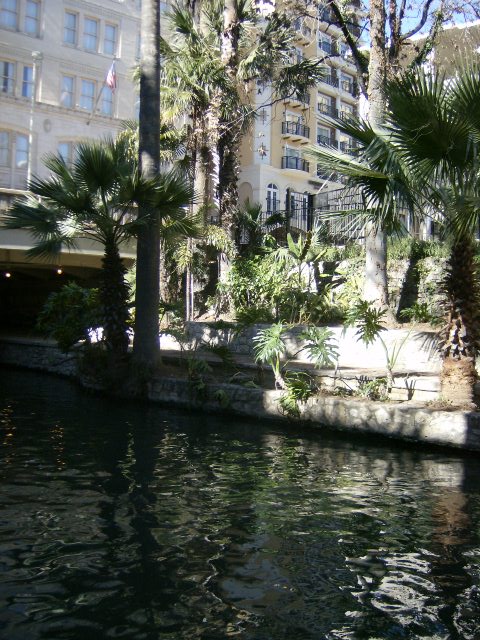
This is  a shot of our hotel.  It is on the right.  I took this picture while we were waiting for our boat to tour the Riverwalk.  The river goes under a bridge and bends to the right, directly behind our hotel.  Notice that all the hotels are at least ten feet above the river's edge. This is the actual river....not a man-made canal, though two canals have been added to the original river.
(Make It The Alamo, Con'td)
Gradually, those stalwarts who stayed in spite of the Comanche raids from the North began to come together as a unit--the Spanish soldiers, the various missions, and the colonists from the Canary Islands.
The city's identity  slowly emerged as a blend of Hispanic and Indian elements  .In fact, those early Bexar residents had much in common with modern-day San Antonio citizens.
But one element was still missing from the "melting pot", and the new Century would witness another invasion from the North--the arrival of the Anglo.
Ironically, this movement  began far to the South were Revolution began against the Spanish government.  The Spanish soldiers fighting the New Spanish (Mexico) citizens were called "Royalists".  Eventually the war reached San Antonio where one of the Revolutionaries,  Bernardo Guitterra de Lara had fled and gained support among the San Antionio people.
But  the Spanish, with an army of 2000,  reclaimed the city and executed anyone known to be loyal to the Revolutionaries as well as many who were neutral.   Large numbers of  residents then fled to the United States, as the purges continued.Â
The population of San Antonio fell drastically.
A shot of the Walgreens downtown.  I liked this because the old signs have been retained rather than new modern ones.
Eventually, however, even the Royalists were forced to admit that  it was necessary  to repopulate the area in order to stave off the Comanche attacks.  One ranch family was generally considered equivalent to 100 soldiers in fighting the Comanches.
Moses Austin, (father of Stephen F. Austin) in 1820 petitioned >the Royalist government for permission to colonize Texas with 300 families from the United States and the Spanish government  agreed.
The stage was then set for the immigration of North American families into the area soon to be known as Texas.
Once the gate was opened nothing could stop the flood of people coming to Texas. When Mexico gained its independence in 1821, it  considered all the land north to the Red River, east to the Louisiana Purchase and west to the mountains to be a part of Mexico now, as it had been claimed by Spain.
Huge tracts of that land had been givern to Spaniards in monstrous land grants by the Spanish monarchy.  Many had created huge cattle ranches and built lavish haciendas on their property.
But Texas was BIG and the lure of thousands of acres of free land brought more and more people into the area   Stephen  F. Austin carried on his father's work to bring the Anglos in when his father died.Â
St. Joseph's Catholic Church
This church  was built by San Antonio's German community in 1876. The Gothic House of Worship is as notable for the intransigence of its congregation as for its stained glass windows.  The worshipers' refusal to move from the site when stores were rising up all around it has kept it a part of the history of downtown San Antonio.  It sits just south of the Alamo and a bit east
The good  Father was kind enough to let me step inside to take a shot of the altar, which was lovely.  The time was late afternoon, so I took two shots on different settings.  The next one will show the lights better but has less detail than this one.
After Mexico won its independence, many of the missions, which had been funded by the Spanish government fell into disarray.  A large number of the priests, who had not been nearly as successful in converting the Indians as they had hoped, returned to Spain.
By the early 1830's, Â the tidal wave of new Texians (as the early settlers were called) outnumbered Hispannics ten to one. Â Mexico had other concerns, so they alloiwed the Texians a great deal of latitude.
That all changed in 1835 when a young firebrand named Antonio Lopez de Santa Anna became governor of Mexico.
The stage was now set for the conflict between Santa Anna and The Texans at the Alamo. (To Be Continued)
This is a shot I took as I was out walking and shooting pictures. Â I can't remember what the plaque said! Â Sorry!
The Menger Hotel
German immigrant William Menger opened this hotel, which is located right across the street from the Alamo in 1859.  Hard drinking cowboys from the ranches slept there as did Presidents, Civil War Generals, including Robert E. Lee writers; among them O'Henry, who mentions the hotel in several of his short stories; and the noted sculptor Gutzun Borglan, the designer of Mount Rushmore who retained a studio at the Menger.  Oscar Wilde also favored the Menger.
Today, the  hotel has been renovated but retains its magnificent Victorian lobby with many of the original accouterments.  It is a favorite of tourists because of its history, its fine restaurant, huge swimming pool and spa as well as its proximity to the Riverwalk, shopping, and the Alamo.Â
/p>







